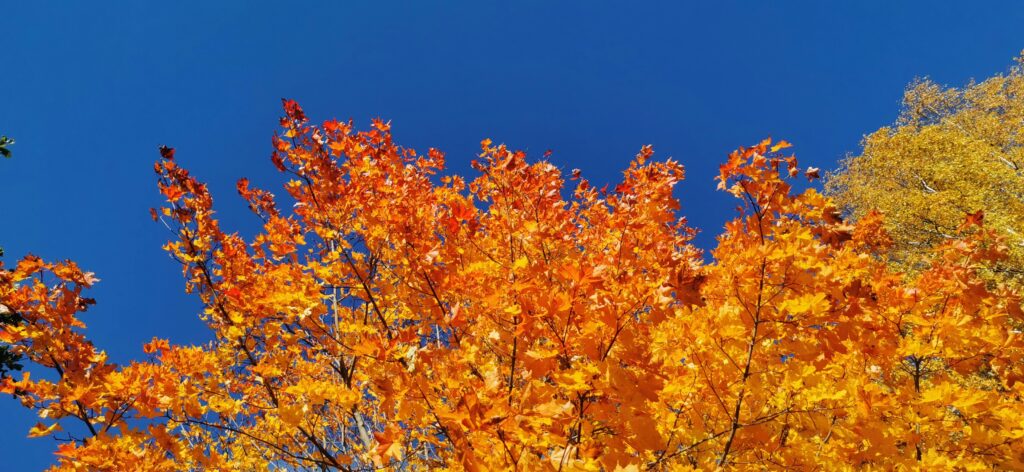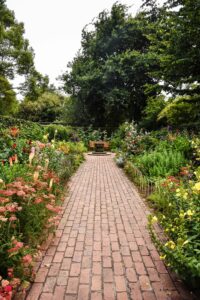Autumn is a season of breathtaking beauty, where trees undergo a stunning transformation that paints the landscape in vibrant hues. The crisp air, the crunch of fallen leaves underfoot when we walk our gardens or landscapes, and the changing colours of the trees are quintessential signs of this season. When exploring the landscape during autumn, there are several highlights to look for in trees, including their leaf colour, seeds, and bark, which all contribute to the distinctive charm of this time of year.
leaf colour
The most obvious and celebrated feature of trees in autumn is the dramatic change in leaf colour. As temperatures drop and daylight hours shorten, trees begin to prepare for winter by shutting down their food production process, known as photosynthesis. Chlorophyll, the pigment responsible for the green colour of leaves, breaks down and reveals the other pigments present in the leaf. These pigments—carotenoids, anthocyanins, and tannins—are responsible for the yellow, orange, red, and brown colours that define the autumn landscape.

Maple Trees: Maple trees are among the most famous for their autumn display. The sugar maple (Acer saccharum) is particularly renowned for its brilliant red, orange, and yellow leaves. The red maple (Acer rubrum) can range from a vivid red to orange and even deep purple. These vibrant colours make maple trees a focal point in any autumn scene.
The sweet gum tree shown here provides a breathtaking change in colours. We have planted these trees in clay soils as we know they grow well, and our clients enjoy them for the years ahead.
Aspen and Birch Trees: Aspen (Populus tremuloides) and birch (Betula spp.) trees are known for their striking golden-yellow leaves. The aspen’s leaves shimmer in the breeze, creating a mesmerizing effect, while birch trees, with their white bark and bright yellow foliage, create a stunning contrast that brightens the landscape.
A classic tree is Betula jaquemontii as a tree with white bark.
Oak Trees: Oak trees, such as the red oak (Quercus rubra) typically display a more subdued but equally beautiful range of colours. The leaves of red oaks often turn a rich reddish-brown, these colours tend to persist longer on the trees, contributing to the longevity of the autumn display. We particularly like these trees when planted roadside, so they have enough space to grow and are visually stunning to many.

Cherry and Dogwood Trees: Cherry (Prunus spp.) and dogwood (Cornus spp.) trees are often overlooked, but they offer some of the most vivid reds in the autumn palette. The leaves of the flowering dogwood (Cornus florida) can range from purple to scarlet, while cherry trees often display a range of red to deep orange hues.
seeds and fruits
Autumn is also the time when many trees produce seeds and fruits, which not only play a crucial role in the tree’s reproductive cycle but also add to the visual and ecological richness of the season.
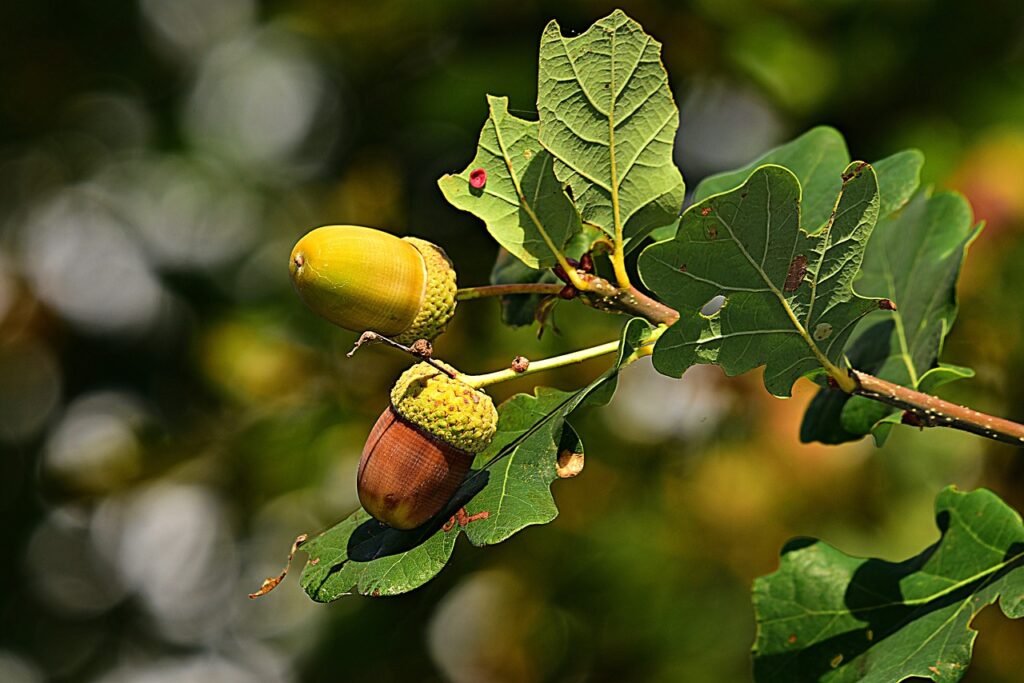
Acorns from Oak Trees: One of the most recognizable seeds of autumn is the acorn, produced by oak trees. Acorns are not only vital for the propagation of oaks but also serve as a critical food source for wildlife, including squirrels, deer, and birds. The sight of acorns scattered on the ground is a sure sign of autumn and an important element of the seasonal landscape.
Maple Samaras: Maple trees produce winged seeds known as samaras, which are often referred to as “helicopters” due to the way they spin as they fall to the ground. These seeds add a playful dynamic to the autumn air, especially when caught in a breeze. They also contribute to the tactile experience of autumn, as children and adults alike often collect and play with them.
Beech Nuts: The beech tree (Fagus spp.) produces small, triangular nuts encased in a spiky husk. These nuts are another important food source for wildlife and can be found on the forest floor amidst the fallen leaves. The unique texture of the beech nut husks adds an interesting element to autumn walks.
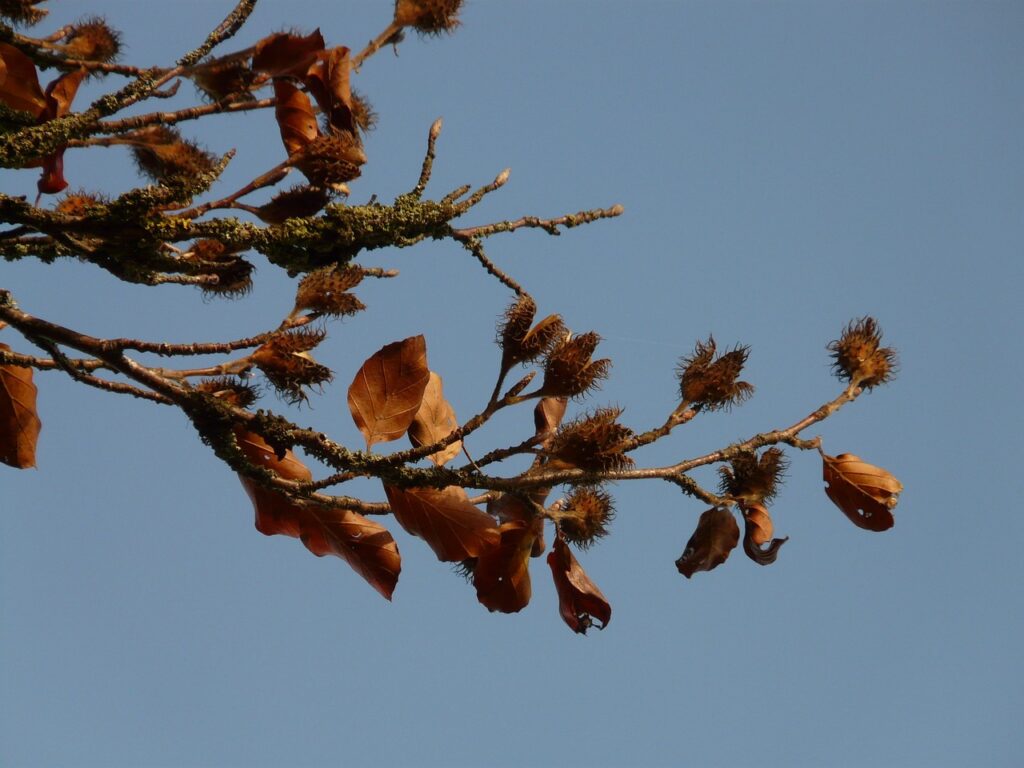
Cones from Pine and Spruce Trees: While pine (Pinus spp.) and spruce (Picea spp.) trees are evergreen and do not display the same colourful transformation as deciduous trees, their cones become more noticeable in autumn as they mature and fall to the ground. These cones are essential for the reproduction of these trees and also provide food for animals like squirrels and birds.
Bark Characteristics
In autumn, as the leaves fall and the branches become more exposed, the bark of trees takes on a greater significance in the landscape. The texture, colour, and patterns of tree bark can be appreciated more fully in the absence of foliage.

Birch Bark: The white, papery bark of birch trees stands out starkly against the autumn landscape, especially when contrasted with the bright yellow of the birch leaves. The bark of the paper birch (Betula papyrifera) can peel off in thin, curling strips, adding to the tree’s visual interest.
Pine Bark: The bark of pine trees, especially older specimens, can be quite dramatic. The bark of the ponderosa pine (Pinus ponderosa), for example, is thick and deeply furrowed, often displaying a reddish-brown colour. This rugged texture contrasts with the softer, needle-covered branches, adding another layer of complexity to the autumn forest.
Sycamore Bark: The sycamore tree (Platanus occidentalis) has a very distinctive bark that flakes off in patches, revealing a mottled pattern of green, brown, and white. In autumn, as the leaves fall, the sycamore’s unique bark becomes a focal point, providing visual interest even after the tree has shed its foliage.
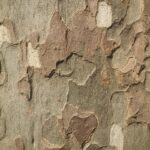
The Role of Trees in the Autumn Landscape
Beyond their individual characteristics, trees play a broader role in shaping the autumn landscape. The overall composition of trees, with their varying heights, shapes, and colours, creates a tapestry of natural beauty that defines the season.
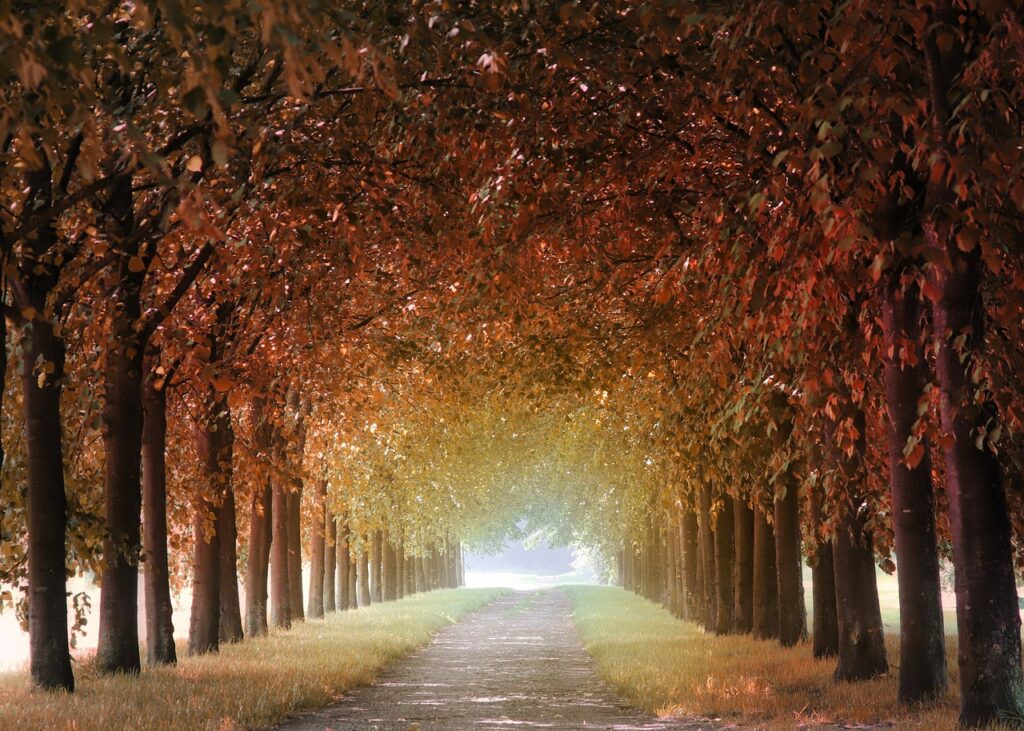
Framing Views: Trees also serve to frame views, guiding the eye towards particular features in the landscape. A row of trees along a path or a stand of colourful maples around a lake can draw attention to these areas, making them focal points in the autumn scene. The contrast between the vivid colours of the leaves and the more subdued tones of the sky or water can create striking compositions that are a delight to behold.
Creating Visual Depth: Trees in autumn often create a sense of depth in the landscape. The mix of evergreen and deciduous trees, combined with the varying heights of different species, can give the illusion of a multi-layered canvas. The interplay of light and shadow, particularly during the golden hours of sunrise and sunset, enhances this effect, making the landscape appear almost three-dimensional.
Providing Habitat: In addition to their visual appeal, trees in autumn provide critical habitat for wildlife. The fallen leaves create a rich layer of organic matter on the forest floor, which is essential for the health of the ecosystem. Small mammals, insects, and fungi all thrive in this environment, contributing to the biodiversity of the area. The seeds and nuts produced by trees are a crucial food source for many species as they prepare for winter.
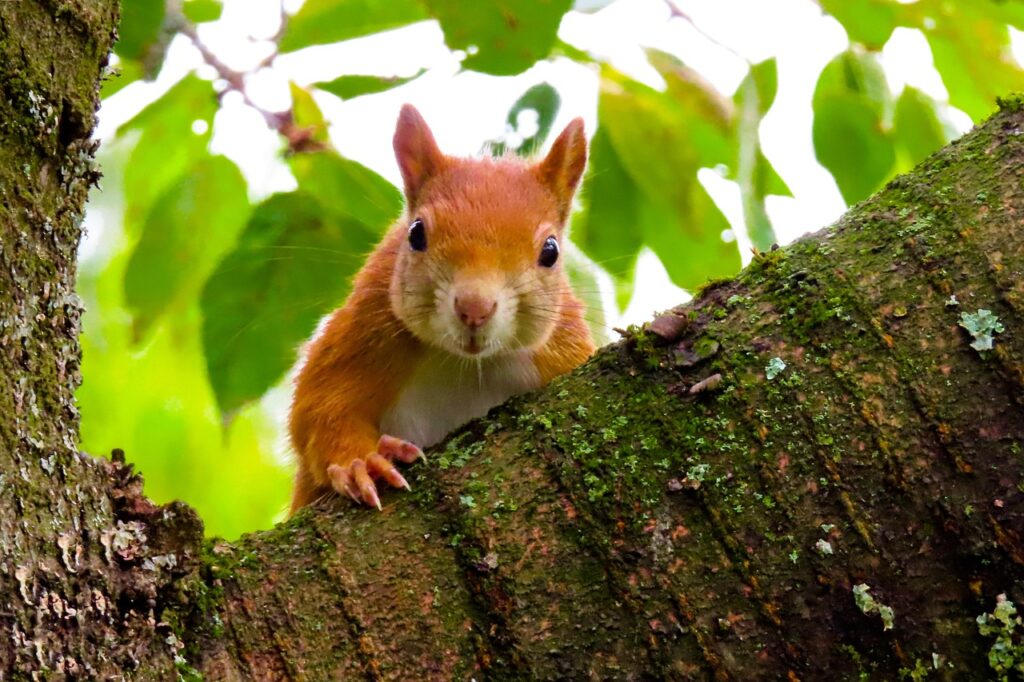
The Ephemeral Nature of Autumn: The beauty of autumn is fleeting, which makes it all the more precious. The colours of the leaves, the presence of seeds and fruits, and the textures of the bark are all temporary features that will soon be gone as winter approaches. This ephemerality encourages us to slow down and appreciate the present moment, to take in the sights, sounds, and smells of the season before they disappear.
Appreciating Trees in the Context of Change
Autumn is a season of transition, and the changes in trees reflect the broader theme of change in the natural world. The shift from the lush greenery of summer to the bare branches of winter is marked by a period of intense beauty, as trees put on a final display before entering dormancy.
Cultural and Emotional Resonance: Trees in autumn have a deep cultural and emotional resonance. They are often associated with themes of change, aging, and the passage of time. The sight of a lone tree in a field, ablaze with autumn colours, can evoke feelings of nostalgia, melancholy, or contemplation. These trees remind us of the cyclical nature of life and the beauty that can be found in every stage of that cycle.
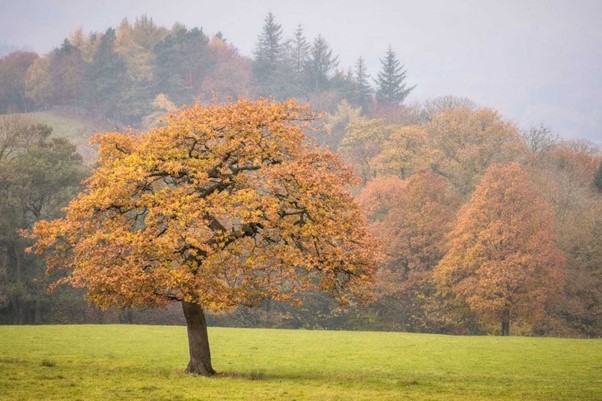
A Source of Inspiration: Finally, trees in autumn are a source of inspiration for artists, writers, and nature lovers. The rich colours, varied textures, and dynamic compositions of the autumn landscape have been captured in countless paintings, photographs, and poems. For those who spend time in nature, the trees of autumn offer endless opportunities for observation, reflection, and creative expression.
Conclusion
Autumn is a time when trees take centre stage in the natural world, offering a display of colour, texture, and form that is unmatched in any other season. From the vivid hues of maple leaves to the rough texture of oak bark, from the playful dance of maple samaras to the sturdy presence of pinecones, trees provide a rich tapestry of sights and experiences that define the autumn landscape. As the days grow shorter and the air grows cooler, the trees remind us of the beauty in change and the importance of appreciating the present moment. Whether you are walking through a forest, sitting by a lake, or simply gazing out your window, the trees of autumn invite you to pause, look, and wonder at the natural world in all its glory.
